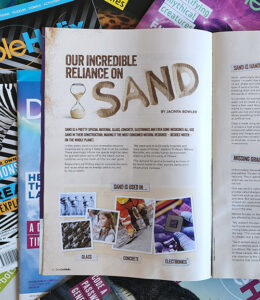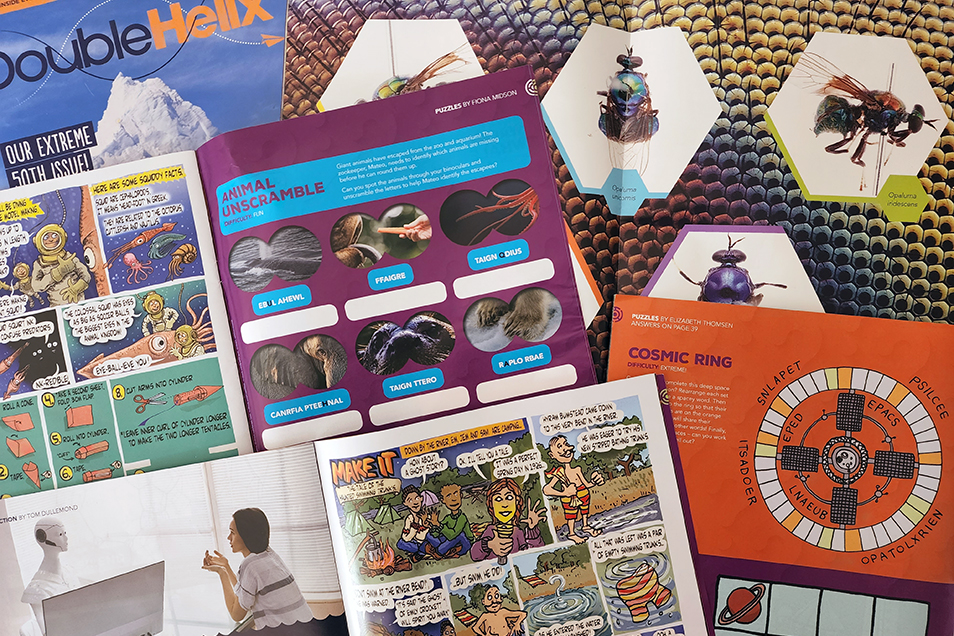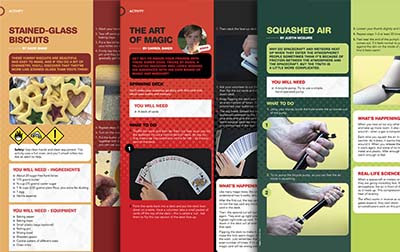Six reasons to use Double Helix magazine in your classroom

You name the topic, we’ve probably covered it!
Double Helix has been inspiring school-aged readers throughout Australia, and even overseas, for over 35 years. But our magazine isn’t just a great read on the weekends, it can be a valuable resource for teachers in the classroom too!
If you’re a teacher, here are six excellent reasons why you should use Double Helix with your students.
1. Inspire future scientists: 84 per cent of our readers are more interested in science than before they started reading Double Helix*
Our magazine is designed to foster an interest in science, technology, engineering and maths (STEM). We aim to make it an easy, fun read for people, whether they are already interested in science or not.
We’ve been publishing Double Helix for a few decades now, and we’ve seen how the magazine has inspired many of our readers to grow into scientists themselves. Read a few of their stories on the Double Helix blog.
*Based on results of the 2020 Double Helix reader survey.
2. Published by STEM qualified editors at CSIRO, Australia’s National Science Agency
Being part of CSIRO helps Double Helix report on the latest science. The editorial team works onsite with researchers, so they get to meet and talk with many of CSIRO’s amazing STEM professionals, and have access to experts in Indigenous engagement, diversity and inclusion, sustainability, education, and more. This amazing network of professionals helps create trustworthy content that’s just the right blend of exciting, accurate, inspiring, and respectful.
The Double Helix editorial team has qualifications covering maths to genetics, and even extend to history and philosophy of science! Having trained at a tertiary level across a range of STEM subject areas, their eagle-eyes are well trained for accuracy. Plus, they’ve been using their writing and editing experience to find the best plain language options to explain science to young readers.

Sand is essential to so much of our urban life, including its necessity in glass, engineering and electronics.
3. Bridge the gap between textbooks and the real world, with examples of the latest STEM research
The content within Double Helix magazine promotes critical thinking, numeracy and literacy, provides real-world examples to illustrate key curriculum areas such as statistics and probability, and science inquiry, plus supports cross-curriculum priorities such as Aboriginal and Torres Strait Islander histories and cultures, and sustainability.
Students learn how Indigenous knowledge is helping to restore ecosystems such as oyster reefs, they can read about the peculiar adaptations of weird and wonderful creatures of the deep, and get to know the chemistry of glue while discovering other sticky and gooey things.
4. Comics and puzzles make great extension material for students
Keep your students entertained with puzzles, comics and short fiction stories from Double Helix magazine.
Kids can test themselves with a quick quiz, melt their minds with our brainteasers or be delighted by an amusing (yet science-y!) comic.
Plus, decorate your classroom with the amazing posters included in each issue!

Our comics, puzzles, quizzes and brainteasers will keep curious minds occupied.
5. Tried, tested and FUN hands-on activities, using materials you can find at school or home

Three of the many fabulous and fun activities from recent issues of the magazine. And yes, some of the activities are even edible!
Grab a bunch of toothpicks, a few rubber bands and some coloured paper. Now you’re ready to tackle some of the hands-on activities you might find in any given issue of the magazine!
Your students will learn about science, maths and engineering through investigation, observation and application… all while making lemon volcanoes, building cone rockets or baking delicious stained-glass biscuits.
Science has never tasted so good!
6. We interview top Australian scientists, so your students can hear from the source
Ever wondered about the kind of work Indigenous rangers do, or how a nanoparticle researcher might develop treatments for cancer? You’ll find stories about real Australian scientists in every issue of Double Helix magazine.
We’ve spoken to top Aussie talent in astronomy, chemistry, conservation and robotics, as well as up-and-coming young research stars like students and CSIRO cadets.
And because we think it’s important to see how science can lead to all kinds of awesome careers, we’ve also interviewed folks who are not researchers, but who use science in their work, from chocolate makers to magicians… we’ve even chatted to Ryan ‘LEGO Brickman’ McNaught. Oh, the places you’ll go with science!
Here’s what Fi Morrison, who reviewed Double Helix for STEM | ED Magazine, had to say about the magazine’s usefulness in the classroom:
“Each issue is based around a particular theme… which I believe is a fantastic way to tailor these magazines for student learning as it can support educators to utilise these magazines as an inquiry unit resource.
I also love how this magazine supports student voice by allowing for student writers to be involved in the writing process – a great opportunity for your students to engage in an authentic learning experience in an inquiry unit!”


